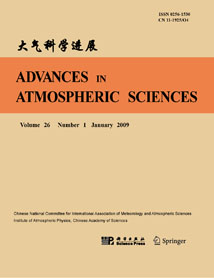| [1] |
ZHANG Min, TIAN Wenshou, CHEN Lei, LU Daren,
2010: Cross-Tropopause Mass Exchange Associated with a Tropopause Fold Event over the Northeastern Tibetan Plateau, ADVANCES IN ATMOSPHERIC SCIENCES, 27, 1344-1360.
doi: 10.1007/s00376-010-9129-9
|
| [2] |
Olivia MARTIUS, Cornelia SCHWIERZ, Michael SPRENGER,
2008: Dynamical Tropopause Variability and Potential Vorticity Streamers in the Northern Hemisphere ---A Climatological Analysis, ADVANCES IN ATMOSPHERIC SCIENCES, 25, 367-380.
doi: 10.1007/s00376-008-0367-z
|
| [3] |
LI Dan, BIAN Jianchun,
2015: Observation of a Summer Tropopause Fold by Ozonesonde at Changchun, China: Comparison with Reanalysis and Model Simulation, ADVANCES IN ATMOSPHERIC SCIENCES, 32, 1354-1364.
doi: 10.1007/s00376-015-5022-x
|
| [4] |
J.R. Kulkarni, R.K. Verma,
1993: On the Spatio-Temporal Variations of the Tropopause Height over India and Indian Summer Monsoon Activity, ADVANCES IN ATMOSPHERIC SCIENCES, 10, 481-488.
doi: 10.1007/BF02656973
|
| [5] |
HAN Bo, LU Shihua, AO Yinhuan,
2010: Analysis on the Interaction between Turbulence and Secondary Circulation of the Surface Layer at Jinta Oasis in Summer, ADVANCES IN ATMOSPHERIC SCIENCES, 27, 605-620.
doi: 10.1007/s00376-009-9015-5
|
| [6] |
Tianjun ZHOU, Wenxia ZHANG, Lixia ZHANG, Robin CLARK, Cheng QIAN, Qinghong ZHANG, Hui QIU, Jie JIANG, Xing ZHANG,
2022: 2021: A Year of Unprecedented Climate Extremes in Eastern Asia, North America, and Europe, ADVANCES IN ATMOSPHERIC SCIENCES, 39, 1598-1607.
doi: 10.1007/s00376-022-2063-9
|
| [7] |
Zhao Bolin, Zhang Xiaoli, Zhu Yuanjing,
1992: Study on Cloud-Radiation Effect on Climate in Eastern Asia, ADVANCES IN ATMOSPHERIC SCIENCES, 9, 257-268.
doi: 10.1007/BF02656936
|
| [8] |
Li XU, Lin DU, Narcisse T. TSONA, Maofa GE,
2021: Anthropogenic Effects on Biogenic Secondary Organic Aerosol Formation, ADVANCES IN ATMOSPHERIC SCIENCES, 38, 1053-1084.
doi: 10.1007/s00376-020-0284-3
|
| [9] |
Zipeng YUAN, Xiaoyong ZHUGE, Yuan WANG,
2020: The Forced Secondary Circulation of the Mei-yu Front, ADVANCES IN ATMOSPHERIC SCIENCES, 37, 766-780.
doi: 10.1007/s00376-020-9177-8
|
| [10] |
Zhong Zhong, Wang Hanjie,
2000: A Study of the Relationship between Low-level Jet and Inversion Layer over an Agroforest Ecosystem in East China Plain?, ADVANCES IN ATMOSPHERIC SCIENCES, 17, 299-310.
doi: 10.1007/s00376-000-0011-z
|
| [11] |
Yiwu HUANG, Yihong DUAN, Johnny C. L. CHAN, Xuwei BAO,
2019: A Method for Diagnosing the Secondary Circulation with Saturated Moist Entropy Structure in a Mature Tropical Cyclone, ADVANCES IN ATMOSPHERIC SCIENCES, , 804-810.
doi: 10.1007/s00376-019-9054-5
|
| [12] |
Xuwei BAO, Leiming MA, Jianyong LIU, Jie TANG, Jing XU,
2018: Formation and Development of a Mountain-induced Secondary Center inside Typhoon Morakot (2009), ADVANCES IN ATMOSPHERIC SCIENCES, 35, 1160-1176.
doi: 10.1007/s00376-018-7199-2
|
| [13] |
Roeland Cornelis JANSEN, SHI Yang, CHEN Jianmin, HU YunJie, XU Chang, HONG Shengmao, LI Jiao, ZHANG Min,
2014: Using Hourly Measurements to Explore the Role of Secondary Inorganic Aerosol in PM2.5 during Haze and Fog in Hangzhou, China, ADVANCES IN ATMOSPHERIC SCIENCES, 31, 1427-1434.
doi: 10.1007/s00376-014-4042-2
|
| [14] |
Nannan QIN, Liguang WU,
2024: Roles of Upper-Level Descending Inflow in Moat Development in Simulated Tropical Cyclones with Secondary Eyewall Formation, ADVANCES IN ATMOSPHERIC SCIENCES.
doi: 10.1007/s00376-023-3075-9
|
| [15] |
yingchuan yang, Wenyi Yang, xueshun chen, Jiawen Zhu, huansheng chen, Wang Yuanlin, Wending Wang, Lianfang Wei, Ying Wei, Ye Qian, Huiyun Du, Wu Zichen, wang zhe, jie li, Xiaodong Zeng, Zifa Wang,
2024: Contrast of Secondary Organic Aerosols in the Present Day and the Preindustrial Period: the importance of nontraditional sources and the changed atmospheric oxidation capability., ADVANCES IN ATMOSPHERIC SCIENCES.
doi: 10.1007/s00376-024-3281-0
|
| [16] |
Zhao Bolin, Yu Xiaoding,
1990: On Eastern Asian Dust Storm, ADVANCES IN ATMOSPHERIC SCIENCES, 7, 11-26.
doi: 10.1007/BF02919164
|
| [17] |
LI Mingwei, WANG Yuxuan*, and JU Weimin,
2014: Effects of a Remotely Sensed Land Cover Dataset with High Spatial Resolution on the Simulation of Secondary Air Pollutants over China Using the Nested-grid GEOS-Chem Chemical Transport Model, ADVANCES IN ATMOSPHERIC SCIENCES, 31, 179-187.
doi: 10.1007/s00376-013-2290-1
|
| [18] |
LIU Run, LIU Shaw Chen, Ralph J. CICERONE, SHIU Chein-Jung, LI Jun, WANG Jingli, ZHANG Yuanhang,
2015: Trends of Extreme Precipitation in Eastern China and Their Possible Causes, ADVANCES IN ATMOSPHERIC SCIENCES, 32, 1027-1037.
doi: 10.1007/s00376-015- 5002-1
|
| [19] |
Wen WU, Fei JI, Shujuan HU, Yongli HE,
2024: Asymmetric Drying and Wetting Trends in Eastern and Western China, ADVANCES IN ATMOSPHERIC SCIENCES, 41, 221-232.
doi: 10.1007/s00376-022-2216-x
|
| [20] |
Xu Yuantai, Li Hongzhou,
1989: A Numerical Experiment of Mesolow on the Eastern Side of the Taihang Mountains, ADVANCES IN ATMOSPHERIC SCIENCES, 6, 133-136.
doi: 10.1007/BF02656924
|















 AAS Website
AAS Website 
 AAS WeChat
AAS WeChat 
 DownLoad:
DownLoad: